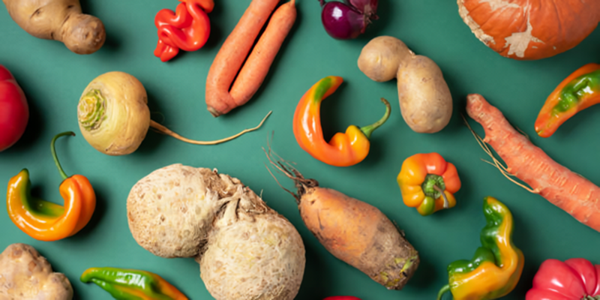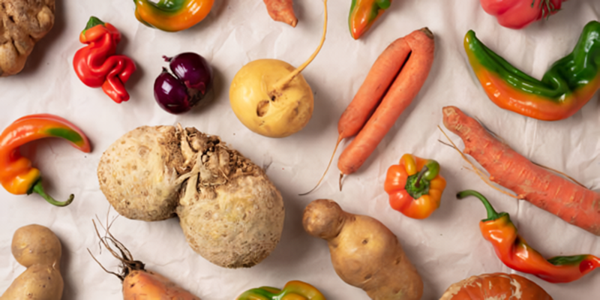The Rise Of ‘Ugly’ Produce: Fighting Food Waste With Imperfect Vegetables
Vegetables bearing irregular morphologies, epidermal aberrations, or atypical chromaticity, frequently labelled as ugly produce, are garnering heightened cognizance among perspicacious consumers increasingly attuned to the difficulties of alimentary waste abatement. These gastronomic anomalies, notwithstanding their ostensibly imperfect exteriors, retain their plenary nutritive essence and gastronomic potentiality. The burgeoning imperfect food movement is inexorably disassembling entrenched canons of aesthetic acceptability within the agricultural sector, accentuating the ugly produce benefits that harbour the capacity to engender profound transformations within our alimentary conduits.

The Imperative Of Ugly Produce
- Mitigates Alimentary Squander: A paramount corollary among the ugly produce benefits lies in its efficacy in profoundly diminishing alimentary squander. Annually, vast quantities of consumable comestibles are jettisoned solely for failing to adhere to superficial aesthetic criteria.
- Advocates for Agro-Sustainability: The imperfect food movement engenders a paradigm shift whereby agriculturalists are incentivized to commercialize the entirety of their yield, not merely the visually pristine fraction.
- Augments Regional Economies: Acquiring ugly produce frequently entails direct commercial engagements with agronomists or local purveyors, stimulating regional economic structures.
- Catalyzes Gastronomic Ingenuity: Imperfect produce frequently serves as a catalytic stimulus for gastronomic innovation.
Stratagems For Alimentary Waste Reduction
Reducing alimentary waste is imperative for both ecological preservation and economic prudence. Below are some methodical food waste reduction tips:
Engage in Preemptive Gastronomic Orchestration: Methodical meal orchestration and adherence to a prescriptive shopping compendium can preempt over-procurement.
- Optimize Alimentary Conservation Techniques: Employing judicious alimentary conservation methodologies, such as storing vegetables and fruits in permeable receptacles in thermally moderated environments.
- Maximize Edibility of Vegetal Components: Exploit the entirety of the vegetable’s comestible parts, from radix to folium.
Cryogenically Preserve Excess Produce: In cases of superfluous produce, cryogenic preservation for subsequent consumption is efficacious.
- Ingeniously Repurpose Residuals: Leftover vegetables can be creatively repurposed into potages, ragouts, or nutrient-dense libations.
The Macrocosmic Impact Of The Imperfect Food Movement
The imperfect food movement transcends mere trendiness. It is emblematic of an escalating cultural paradigm shift toward sustainable praxis and conscientious consumption.
Quintessential Takeaways:
- Ecological Ramifications: The imperfect food movement is instrumental in attenuating the ecological footprint of food production and waste.
Economic Incentives: Consumers can achieve fiscal economization while concurrently supporting local agronomists by purchasing ugly produce.
Nutritional Equivalence: Ugly produce offers identical nutritional benefits to its aesthetically flawless counterparts, making it an invaluable inclusion in any alimentary regimen.
Transmuting Consumer Sentiment
- Augmenting Cognitive Dispositions: A crucial tenet of the imperfect food movement necessitates an epistemic shift among consumers, fostering an enlightened appreciation of the ugly produce benefits that transcend rudimentary sustainability.
- Societal Dynamics on Market Behaviors: The ascendant tide of social media crusades and digital influencers championing the imperfect food movement catalyzes a perceptible reconfiguration in consumer behaviour, whereby the consumption of ugly produce is valorized as a symbol of environmental stewardship.
Paradigmatic Shifts In Alimentary Logistics
- Technological Catalysis: The advent of algorithm-driven platforms dedicated to the imperfect food movement has engendered a paradigm shift in how consumers procure ugly produce. These platforms synergize surplus produce from agrarian sources directly with consumers, gastronomy establishments, and philanthropic organizations, optimizing logistical frameworks and curtailing alimentary wastage.
- Bespoke Distribution Mechanisms: The proliferation of subscription-based services that furnish ugly produce benefits directly to consumers’ domiciles epitomizes the intersection of convenience with sustainability. These bespoke delivery models ensure a continuous supply of seasonal, imperfect vegetables, fortifying the nexus between consumer demand and sustainable alimentary practices.
Nutritional And Health Paradigms
- Preservation of Nutritional Value: In stark contrast to pervasive fallacies, the nutritional composition of ugly produce remains congruent with its visually impeccable counterparts. By incorporating these vegetables into one’s diet, consumers not only engage in food waste reduction tips but also maintain an intake replete with essential micronutrients, vitamins, and antioxidants.
- Strategic Health Marketing: The imperfect food movement stands to gain considerable traction through strategically promoting these vegetables within health-conscious demographics. By positioning ugly produce as a cornerstone of nutritive equilibrium, marketers can captivate an audience that prioritizes dietary wholesomeness, galvanizing this emergent alimentary trend.

Regulatory And Policy Frameworks
- Legislative Imperatives: Governmental endorsement of the imperfect food movement can be actualized through a spectrum of fiscal incentives aimed at agriculturalists and retailers who embrace the commercialization of ugly produce. Subsidies, tax abatements, and direct grants could act as catalysts, incentivizing wider adoption of these sustainable practices.
- Didactic Governmental Campaigns: Beyond financial support, governmental entities can spearhead didactic campaigns that underscore ugly produce benefits while promulgating food waste reduction tips. Integrating these narratives into public health initiatives and educational curricula will fortify the movement's foundational principles nationally.
Socio-Cultural Reconfigurations
- Evolving Aesthetic Standards: The imperfect food movement is at the vanguard of a cultural metamorphosis that redefines societal standards of alimentary aesthetics. Where certain cultures have historically extolled the visual perfection of foodstuffs, there is a developing shift towards valorizing sustainability over superficiality.
- Conscientious Consumerism: The burgeoning emphasis on conscientious consumerism—marked by deliberate, ethical purchasing decisions—resonates deeply with the ethos of the imperfect food movement. This ethos encourages consumers to engage with the broader ecological ramifications of their dietary choices.
Economic Ramifications
Fiscal Prudence of Ugly Produce: Among the often-overlooked benefits of ugly produce is its inherent cost-efficiency. Priced at a relative discount due to its aesthetic divergence, ugly produce represents a fiscally prudent option, particularly within economically marginalized communities. This economic accessibility is instrumental in democratizing access to nutritious food.
Economic Revitalization in Agrarian Sectors: The imperfect food movement has the potential to act as a significant economic stimulant in rural locales, enabling local farmers to commercialize their entire yield, including aesthetically deviant produce.
Agricultural And Technological Innovations
- Precision Agronomy: The advent of precision agronomy facilitates an enhanced approach to crop management, optimizing yield while accommodating the commercial potential of ugly produce. Through the integration of predictive analytics, farmers can anticipate the occurrence of imperfect produce, enabling them to implement preemptive strategies that minimize wastage.
- Innovations in Agri-Tech: Cutting-edge agri-tech solutions, such as automated sorting technologies capable of identifying and categorizing ugly produce, are streamlining the imperfect food movement.
Conclusion
The advent of ugly produce heralds a pivotal advancement towards a more sustainable and efficient alimentary system. By embracing the imperfect food movement and integrating food waste reduction tips into quotidian practices, consumers can significantly reduce nutrient waste. The benefits of ugly produce are incontrovertible: They promote sustainability, fortify local economies, and incite culinary innovation. In an epoch wherein alimentary waste constitutes a burgeoning challenge, ugly produce presents a deceptively simple yet profoundly potent solution.